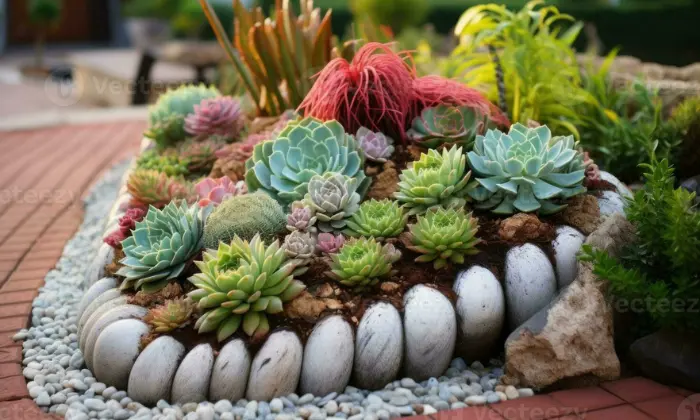Low Maintenance Front Yard Landscaping Tips and Ideas
Low Maintenance front yard landscaping plays a crucial role in…
When it comes to creating a stunning and low-maintenance front yard, succulent gardens are the latest trend that can transform your outdoor space into a captivating oasis. At Robert Complete Care, we believe that a well-designed front yard can greatly enhance the curb appeal of your home. In this article, we will explore a plethora of front yard succulent garden landscape ideas that will not only beautify your property but also reflect your unique style and personality.

Succulents are a fantastic choice for front yard landscaping due to their unique textures, shapes, and vibrant hues. Their ability to thrive in arid conditions makes them well-suited for various climates. By selecting succulents for your garden, you’re not only adding an aesthetic touch but also ensuring easy maintenance.
Planning a front yard succulent garden can add a unique and visually appealing touch to your home’s curb appeal. Here’s a step-by-step guide to help you plan your front yard succulent garden:
Remember, a well-planned front yard succulent garden can be a beautiful and low-maintenance addition to your home. By carefully considering your space, succulent selection, and design elements, you can create a stunning and sustainable landscape that enhances your home’s overall aesthetic.
With a wide array of succulent varieties available, choosing the right ones for your front yard can be exciting. Opt for a mix of sizes, colors, and textures to create an engaging visual display. Hardy succulents like agave and echeveria are great choices for beginners.
Incorporating hardscape elements such as decorative rocks, gravel pathways, and succulent planters can add depth and structure to your front yard. These elements not only complement the succulents but also provide a visually appealing contrast.
Creating eye-catching arrangements involves combining various elements in a visually pleasing and harmonious way. Whether you’re arranging flowers, decor, or any other items, the principles of design remain relatively consistent. Here are some tips to help you create eye-catching arrangements:
Every arrangement should have a focal point that draws the viewer’s attention. This could be a larger or more colorful element, a unique item, or something that contrasts with the rest of the arrangement.
Achieving balance in an arrangement is crucial. There are two main types of balance: symmetrical (where both sides mirror each other) and asymmetrical (where elements have equal visual weight but are not identical).
Contrast adds visual interest. It can be achieved through color, texture, size, or shape. Contrasting elements make each other stand out and create a dynamic composition.
Choose a cohesive color palette that complements the overall theme or purpose of the arrangement. You can use complementary colors (opposite on the color wheel) for a striking effect or analogous colors (adjacent on the color wheel) for a harmonious look.
Consider the size of the items you’re arranging and how they relate to each other. Play with different proportions to create visual intrigue. Oversized items can make a bold statement, while smaller items can add delicate detail.
Establish a hierarchy among the elements in your arrangement. Decide which elements are most important and arrange them accordingly. This helps guide the viewer’s eye through the arrangement.
Incorporate different textures to add depth and tactile interest. Combine smooth, rough, soft, and shiny textures for a multi-dimensional effect.
Repeating certain elements throughout the arrangement can create a sense of unity and cohesiveness. This could involve using the same color, shape, or type of item.
Negative space, also known as white space, is the empty area around the main elements. It provides breathing room and allows the eye to rest. Don’t overcrowd your arrangement; embrace the beauty of empty space.
Create a sense of movement by arranging elements so that they guide the viewer’s eye in a certain direction. This adds energy and flow to the arrangement.
Don’t be afraid to experiment with different arrangements and placements. Sometimes the most unexpected combinations can lead to the most captivating results.
Think about where the arrangement will be placed. Consider the lighting, colors, and overall ambiance of the space to ensure your arrangement complements its surroundings.
Remember, the key to creating eye-catching arrangements is creativity and a willingness to explore different possibilities. Have fun and let your artistic instincts guide you!
Add a burst of color to your succulent garden by introducing companion plants that complement the palette of your succulents. Drought-resistant flowers like lavender or vibrant ornamental grasses can enhance the overall aesthetic.
Maintaining a succulent garden involves some specific care practices to keep these unique plants healthy and thriving. Here are some maintenance tips for your succulent garden:
Allow the soil to dry out completely between waterings. Water your succulents thoroughly but infrequently. In general, water more during the active growing season (spring and summer) and reduce watering in the dormant period (fall and winter).
Overwatering is a common cause of succulent problems. Ensure that the pot has drainage holes and that excess water can escape. Water the soil directly and avoid getting water on the leaves to prevent rot.
Most succulents thrive in bright, indirect sunlight. Place your succulent garden in a location where it receives several hours of sunlight per day. Some succulents can tolerate more direct sunlight, but be cautious of scorching in extremely hot climates.
Succulents generally prefer warmer temperatures during their active growth period. Protect them from frost and extreme cold, especially if they’re not cold-hardy varieties.
Choose appropriately sized containers for your succulents, leaving some room for growth. Overcrowding can lead to poor air circulation and increased risk of disease.
Use a balanced, diluted, and slow-release fertilizer formulated for succulents. Apply the fertilizer sparingly during the growing season (spring and summer) according to the package instructions.
Remove dead or dried-up leaves to maintain a tidy appearance and prevent mold or pests from taking hold. You can also prune leggy or elongated growth to encourage a more compact form.
Keep an eye out for common succulent pests like aphids, mealybugs, and spider mites. If you notice any infestations, isolate the affected plants and treat them promptly with insecticidal soap or neem oil.
As your succulents grow, they may outgrow their containers. Repot them into slightly larger pots with fresh potting mix every couple of years or when you notice the plant becoming root-bound.
Gently dust the leaves of your succulents to allow them to breathe and photosynthesize more effectively. This also helps enhance their natural beauty.
Many succulents have a dormant period during the fall and winter. During this time, they may require even less water and should be kept in a cooler environment.
Take advantage of succulents’ natural ability to propagate easily. You can grow new plants from leaves or stem cuttings. Allow cuttings to callus over for a day or two before planting them in well-draining soil.
Regularly observe your succulents for any signs of stress, disease, or pests. Early detection and intervention can help prevent problems from spreading.
Remember that different types of succulents may have specific care requirements, so it’s a good idea to research the specific needs of the succulents in your garden. With proper care, your succulent garden can be a beautiful and low-maintenance addition to your home or outdoor space.
Succulents are known for their water-storing capabilities, but it’s crucial to water them correctly. Opt for deep, infrequent watering to encourage strong root growth and prevent overwatering.
As colder months approach, safeguard your succulent garden from frost and extreme weather conditions. Consider using frost cloths or moving potted succulents indoors to protect them during winter.
Engage your creative side with engaging DIY projects. Craft succulent wreaths, vertical pallet gardens, or teacup planters to add a personalized touch to your front yard.
A well-maintained succulent garden can significantly enhance your home’s curb appeal. Trim any overgrown succulents, remove debris, and ensure pathways are clear to create a welcoming entrance.
Creating a budget-friendly front yard landscaping can greatly enhance the curb appeal of your home without breaking the bank. Here are some tips to help you transform your front yard on a budget:
Start by creating a well-thought-out plan for your front yard. Decide on the key elements you want to include, such as plants, pathways, and focal points. Prioritize the most important features to allocate your budget effectively.
Build your own garden beds, planters, or even a simple pathway using affordable materials like gravel, mulch, or concrete pavers.
Choose native plants and shrubs that are well-suited to your climate and require less maintenance. Native plants are often more affordable to purchase and care for in the long run.
If you already have some plants in your yard, consider propagating or dividing them to create more plants. This not only saves money but also allows you to fill up space more quickly.
Keep an eye out for plant sales, clearance sections, and discounts at local nurseries and garden centers. You can often find healthy plants at a fraction of the original price.
Mulch and gravel are cost-effective ways to cover large areas of the yard while also helping with weed control and moisture retention.
Get creative with repurposing and upcycling items. Use old containers, crates, or pallets as planters. Turn unused furniture or objects into unique focal points.
Reduce the size of your lawn or replace it with low-maintenance ground covers or gravel. Lawns can require significant maintenance, so minimizing their size can save you time and effort.
Create groupings of plants instead of spacing them out individually. This not only makes a stronger visual impact but also helps plants support each other’s growth.
Consider starting plants from seeds rather than buying fully grown plants. While it requires more time and attention, it can be much more affordable.
Define garden beds and pathways with DIY edging. Use materials like rocks, bricks, or even fallen branches to create borders.
Check if your community offers any resources for free or low-cost plants, such as plant swaps or community gardens.
As you plan your landscaping, prioritize low-maintenance plants and design elements. A low-maintenance yard will save you time and money in the long run.
Implement efficient watering techniques, such as using soaker hoses or drip irrigation, to reduce water waste and lower your water bills.
Remember, a well-designed front yard doesn’t have to be expensive. With careful planning, creativity, and a bit of elbow grease, you can create a beautiful and inviting front yard that fits within your budget.
Elevate your front yard’s charm with a captivating succulent garden. With their versatility, low-maintenance nature, and vibrant beauty, succulents are the perfect choice for an enchanting outdoor space. Explore the myriad of possibilities, unleash your creativity, and transform your front yard into a mesmerizing haven. If you have any questions or need assistance, please don’t hesitate to contact us.
Succulents prefer infrequent, deep watering. Water them thoroughly when the soil is dry to the touch.
While some succulents tolerate partial shade, most thrive in sunlight. Ensure your succulents receive adequate sunlight for optimal growth.
Many succulents can withstand colder temperatures, but it’s important to protect them from frost. Consider covering them during winter or moving potted succulents indoors.
Overwatering can lead to root rot. Make sure the soil has proper drainage, and allow it to dry out between waterings.
Low Maintenance front yard landscaping plays a crucial role in…
Lawn fungus represents a significant challenge for homeowners and landscape…
Best time to water lawn and maintaining a lush, green…
Ensuring optimal grass growth is crucial for maintaining a lush…

Robert’s Complete Care has a proven track record of providing creative, high-quality lawn care Whittier services, CA area.
Copyright © 2023. All rights reserved Robert's Complete Care | Powered by Localpro1.